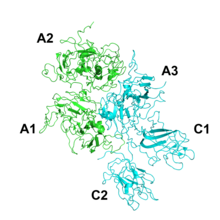Factor VIII (medication)
 A depiction of factor VIII | |
| Clinical data | |
|---|---|
| Trade names | Aafact, Kovaltry, others[1] |
| Other names | octocog alfa |
| AHFS/Drugs.com | Monograph |
| License data | |
Intravenous (IV) | |
| ATC code | |
| Legal status | |
| Legal status | |
| Identifiers | |
| ChemSpider |
|
Factor VIII is a medication used to treat and prevent
slow injection into a vein.[8]
Side effects include skin flushing, shortness of breath,
antibodies to factor VIII such that this medication becomes less effective.[10]
Factor VIII was first identified in the 1940s and became available as a medication in the 1960s.[11][12] Recombinant factor VIII was first made in 1984 and approved for medical use in the United States in 1992.[13][14] It is on the World Health Organization's List of Essential Medicines.[15]
Available forms
Factor VIII is delivered by intravenous infusion.[16]
History
This transfer of a
hemophiliac often led to the transmission of diseases such as HIV and hepatitis before purification methods were improved. In the early 1990s, pharmaceutical companies began to produce recombinant synthesized factor products, which now prevent nearly all forms of disease transmission during replacement therapy.[citation needed
]
Society and culture
Economics
The cost of Factor VIII and similar clotting factors has been described as "highly expensive".gene therapy for haemophilia might be less expensive, especially for people with severe hemophilia.[17]
See also
- Damoctocog alfa pegol, a recombinant antihemophilic factor VIII
- Efmoroctocog alfa, a recombinant antihemophilic factor VIII
- Moroctocog alfa, a recombinant antihemophilic factor VIII
- Susoctocog alfa, a recombinant antihemophilic factor VIII
- Turoctocog alfa, a recombinant antihemophilic factor VIII
References
- ^ "Coagulation Factor VIII, Human". www.drugs.com. Archived from the original on 9 January 2017. Retrieved 8 January 2017.
- ^ "Prescription medicines: registration of new chemical entities in Australia, 2017". Therapeutic Goods Administration (TGA). 21 June 2022. Retrieved 9 April 2023.
- ^ "Prescription medicines: registration of new chemical entities in Australia, 2016". Therapeutic Goods Administration (TGA). 21 June 2022. Retrieved 10 April 2023.
- ^ "Prescription medicines: registration of new chemical entities in Australia, 2014". Therapeutic Goods Administration (TGA). 21 June 2022. Retrieved 10 April 2023.
- ^ "Prescription medicines and biologicals: TGA annual summary 2017". Therapeutic Goods Administration (TGA). 21 June 2022. Retrieved 31 March 2024.
- ^ "Search Page - Drug and Health Product Register". 23 October 2014.
- ^ "Health Canada New Drug Authorizations: 2016 Highlights". Health Canada. 14 March 2017. Retrieved 7 April 2024.
- ^ ISBN 9789241547659.
- ^ ISBN 978-0857111562.
- ^ a b "Alphanate – Summary of Product Characteristics (SPC) – (eMC)". www.medicines.org.uk. Archived from the original on 9 January 2017. Retrieved 8 January 2017.
- ISBN 978-0752471969. Archivedfrom the original on 9 January 2017.
- ISBN 978-1461317616. Archivedfrom the original on 9 January 2017.
- ISBN 978-3034883467. Archivedfrom the original on 9 January 2017.
- ISBN 0443069816. Archivedfrom the original on 9 January 2017.
- hdl:10665/325771. WHO/MVP/EMP/IAU/2019.06. License: CC BY-NC-SA 3.0 IGO.
- ^ S2CID 3779939.
- ^ PMID 30042145.
External links
- "Antihemophilic Factor (Recombinant) Monograph for Professionals". Drugs.com.
- "Antihemophilic Factor (Recombinant), Porcine Sequence Monograph for Professionals". Drugs.com.
- "Antihemophilic Factor (recombinant), Fc Fusion Protein Monograph for Professionals". Drugs.com.
- "Antihemophilic Factor (recombinant), Glycopegylated-exei Monograph for Professionals". Drugs.com.
